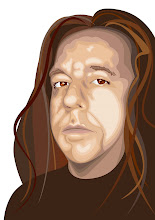2008 saw the first use of direct emails, blogging, Photobucket, and a host of other Internet communication tools delivered to the American voting public by Barack Obama. The campaign made extensive use of well -designed, thematically harmonious tyography and other iconic imagery to deliver a memorable and tasteful impression. During the long campaign, the style was so succesful, it was emulated in popular ads and repurposed. (As if by using the same font (Gotham) and copying colors and layouts one could achieve credibility simply by visual association.) The use of Gotham has diminished since the election, but for about 2 years it was everywhere in print and on the Web.
The designers behind the branding of Barack Obama have distinguished themselves and achieved a level of success that will fuel their careers for a long time. Obama Design
America loves dark characters, bad boys, and anti-heros like Tony Soprano. Graphically compelling work is sometimes of a subversive or questionable nature. Certain artists intentionally pattern their work around just such a subversive or 'underground' ideal. (Sheppard Fairey) (GPS grid art) (viral) Usually, this is intended to bring about a positive political change, or to draw attention to issues the popular media ignore. (post modernism)
The really phenomenal thing is that when a subversive/underground work reaches a level of notoriety that brings it to the attention of popular media, it is consumed by that media to become a new norm, an acceptable standard now devoid of anything for which it initially stood, it's message of political challenge watered down to hip contemporary fashion. (led zeppelin, grunge type, gangsta, harley davidson, rick james) (cool hunting, cultural appropiation and paul simon)
So that's what I want. To create an image that is fresh and alive and noticed by everyone. At first creating sensation, even outrage, but gradually becoming accepted by popular media and critics alike, forever connecting me to the emergence of that image as it's founding father! A moment of critical mass . . . The last big thing that came along was David Carson and grunge type. What will be next? Maybe it comes from you . . .

1 comment:
1. Why do you think the reproduction of image is so prevalent in the world today?
People are more likely to pay attention to a message or idea if it is presented to them in an appealing manner. The reproduction of a image draws viewers to stay and look around at a product if only for a brief moment.
2. What do you think this prevalence bodes for the future of graphic design and your place in it?
Hopefully graphic design becomes more in demand and vital in the future. I know that making it in the artistic field is not always easy but hopefully there will be more opportunities for emerging artists in the future.
3. Why do you think the John McCain drive for the presidency failed to use the Internet (or failed to use it effectively) as a means of communicating with voters?
John McCain's demographic is usually composed of older folks who perhaps don't rely on social media or the internet as much. In this day and age however, if you want to appeal to your voters you will have to emerge yourself into the wireless world.
4. How do the current crop of presidential hopefuls use Internet media to promote their campaigns?
The new crop of presidential hopefuls use the Internet media in order to talk about their policies or criticize their opposing candidate. They post pictures and comment on popular trends and essentially work hard to remain relevant to the public.
Post a Comment